This article relies largely or entirely on a single source .(July 2007) |
The Brothers of the Holy Infancy are a Roman Catholic male religious congregation devoted to the education of boys.
This article relies largely or entirely on a single source .(July 2007) |
The Brothers of the Holy Infancy are a Roman Catholic male religious congregation devoted to the education of boys.
Founded in 1853 by John Timon (1797–1867), the first Bishop of Buffalo, with the special aim of the sanctification of its members and the care of destitute and wayward boys. Soon after becoming bishop, Timon purchased a tract of land in West Seneca, now the city of Lackawanna, and established St. Joseph's Male Orphan Asylum and, a little later, St. John's Protectory for wayward and destitute boys. Thomas Hines was appointed superintendent. These institutions struggled on under a heavy debt until 1882, when Nelson H. Baker was placed in charge. Baker founded the Society of Our Lady of Victory to care for destitute Catholic children. From this time the work prospered.[ citation needed ]
In 1909, under the general title of Our Lady of Victory Home, the following buildings were grouped: St. Joseph's Protectory, with 700 boys; St. Joseph's Orphan Asylum, with 250 boys; Working Boys' Home, with 75 boys; Our Lady of Victory Infant Asylum, caring for about 150. The 23 brothers gave special attention to the trade school of the protectory, where they taught printing, press-feeding, book-binding, baking, shoe-making, tailoring, plumbing, gas-fitting, and other trades.[ citation needed ]
Young men are received from the age of sixteen to thirty-five. After a probation of six months the candidate receives the habit. After two years of the novitiate, the novice takes the vows of poverty, chastity and obedience. The brothers maintain a juniorate in which boys are received from twelve to fifteen years of age and trained to the work carried on by the community. They are governed by the bishop, who appoints a priest to superintend the institution and act as superior. Next in authority are the brother superior and his assistants, who are elected every three years.[ citation needed ]

The Diocese of Brooklyn is a Latin Church ecclesiastical territory or diocese of the Catholic Church in the U.S. state of New York. It is headquartered in Brooklyn and its territory encompasses the New York City boroughs of Brooklyn and Queens. The Diocese of Brooklyn is a suffragan diocese in the ecclesiastical province of the metropolitan Archdiocese of New York. The diocesan cathedral is the Cathedral Basilica of St. James in Downtown Brooklyn and its co-cathedral is the Co-Cathedral of St. Joseph in Prospect Heights. The current Bishop of Brooklyn is Robert J. Brennan.

The Congregation of Holy Cross, abbreviated CSC, is a Catholic clerical religious congregation of pontifical rite for men founded in 1837 by Basil Moreau, in Le Mans, France.

The Sisters of St. Joseph, also known as the Congregation of the Sisters of St. Joseph, abbreviated CSJ or SSJ, is a Catholic religious congregation of women founded in Le Puy-en-Velay, France, in 1650. This congregation, named for Saint Joseph, has approximately 14,000 members worldwide: about 7,000 in the United States; 2,000 in France; and are active in 50 other countries.

The Diocese of Buffalo is a Latin Church diocese of the Catholic Church in Western New York in the United States. It is a suffragan diocese within the metropolitan province of the Archdiocese of New York.
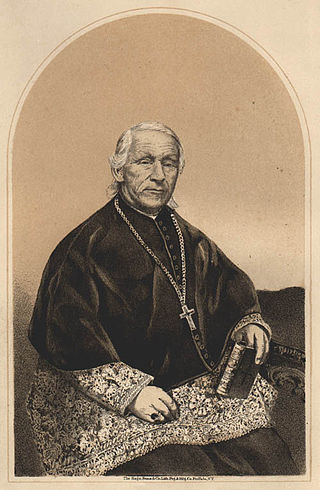
John Timon, C.M. was a prelate of the Roman Catholic Church. He served as the bishop of the new Diocese of Buffalo in Western New York and founder of the brothers of the Holy Infancy religious order.
The Sisters of St. Joseph of Carondelet (CSJ) are a Roman Catholic congregation of women religious which traces its origins to a group founded in Le Puy-en-Velay, France around 1650 by Jean Pierre Medaille, S.J. The design of the congregation was based on the spirituality of the Society of Jesus. The Sisters of St. Joseph of Carondelet became a separate congregation of pontifical right on May 16, 1877.
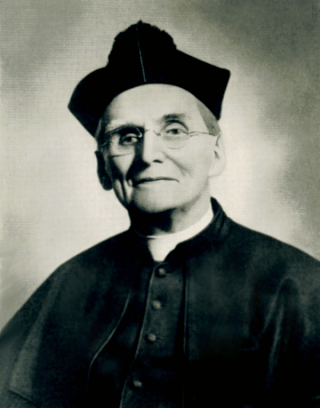
Nelson Henry Baker was a Catholic priest and church administrator in the Buffalo, New York, area. At the time of his death in 1936, he had developed a "city of charity" at Our Lady of Victory Basilica in Lackawanna, New York. It consisted of a minor basilica, an infant home, a home for unwed mothers, a boys' orphanage, a boys' protectory, a hospital, a nurses' house, and a grade and high school.
A protectory was a Roman Catholic institution for the shelter and training of the young, designed to afford neglected or abandoned children shelter, food, raiment and the rudiments of an education in religion, morals, science and manual training or industrial pursuits.

Levi Silliman Ives was an American theologian and Episcopal bishop of North Carolina. In 1852, he converted to Roman Catholicism. Ives subsequently became a noted professor at colleges in the New York area. He was the founder and first president of the New York Catholic Protectory, an institution for the shelter and education of destitute and abandoned children. He was also a founder of Manhattan College.

The Congregation of Our Lady of Charity of the Good Shepherd, also known as the Sisters of the Good Shepherd, is a Catholic religious order that was founded in 1835 by Mary Euphrasia Pelletier in Angers, France. The religious sisters belong to a Catholic international congregation of religious women dedicated to promoting the welfare of women and girls.

The Orphan Train Movement was a supervised welfare program that transported children from crowded Eastern cities of the United States to foster homes located largely in rural areas of the Midwest. The orphan trains operated between 1854 and 1929, relocating from about 200,000 children. The co-founders of the Orphan Train movement claimed that these children were orphaned, abandoned, abused, or homeless, but this was not always true. They were mostly the children of new immigrants and the children of the poor and destitute families living in these cities. Criticisms of the program include ineffective screening of caretakers, insufficient follow-ups on placements, and that many children were used as strictly slave farm labor.
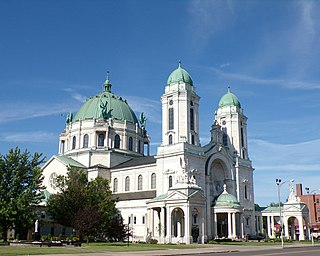
The Our Lady of Victory Basilica is a Catholic parish church and national shrine in Lackawanna, New York. Due to the multiple charities of founder Father Nelson Baker, the shrine is a popular pilgrimage and visitor destination in Lackawanna. It is part of the Diocese of Buffalo.

Sisters of Charity Hospital is a general medical and surgical hospital founded in 1848 by the Daughters of Charity of St. Vincent de Paul, and the oldest hospital in Buffalo, New York. Part of Catholic Health, it is also a teaching hospital affiliated with the New York Institute of Technology College of Osteopathic Medicine as a clinical campus of the medical school to provide clinical clerkship education to osteopathic medical students. The hospital has 467 beds and specializes in women's health services.

Lincolndale Agricultural School for Boys was a Catholic charity run by Barnabas McDonald in Lincolndale, New York. It opened in 1912 for orphans to be trained for agricultural and industrial work. In time, this evolved into Lincoln Hall, which remains active in 2021.

The Sisters of Providence of Holyoke, Massachusetts, are a congregation of Roman Catholic religious sisters founded in 1892.
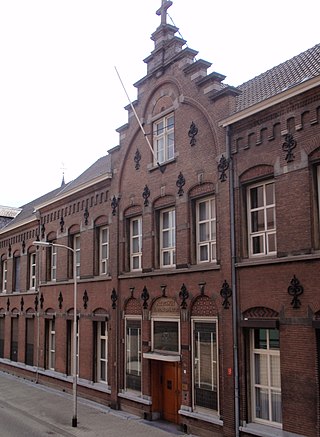
The Sisters of Charity of Our Lady Mother of Mercy (SCMM) are a Roman Catholic congregation founded in the Netherlands in 1832 by Johannes Zwijsen, pastor of Tilburg, aided by Mary M. Leijsen, for the instruction of children and the betterment of people deprived of spiritual aid. The motherhouse is in Tilburg.
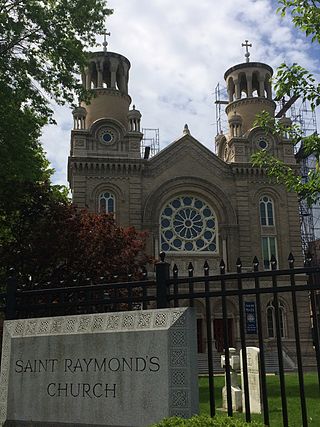
St. Raymond's Church is a parish church under the authority of the Roman Catholic Archdiocese of New York, located at Castle Hill Avenue at Tremont Avenue, The Bronx, New York City. The parish was established in 1842. It was dedicated on the feast of St. Raymond Nonnatus, on August 31, 1845, thus getting its name. There is a stained glass window, on the right side if you are looking at the sanctuary, of St. Raymond Nonnatus and the men who took him hostage.
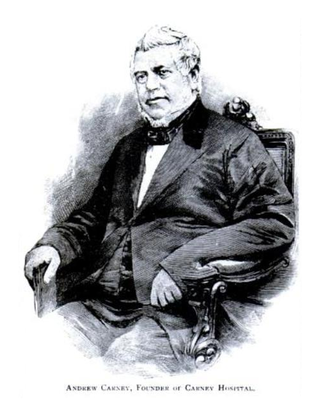
Andrew Carney (1794–1864) immigrated to the United States in 1816. Carney partnered with Jacob Sleeper to form Carney & Sleeper, Clothiers. Carney was a wise investor and grew his fortune with investments in Boston's real estate market. Carney's interests turned to finance and he assisted in founding the First National Bank of Boston and the John Hancock Insurance Company for which he worked as a director. Carney cared for the youth of Boston by founding the St. Vincent Home for Girls, and was a benefactor of the House of the Angel Guardian for Homeless Boys and the Home for Destitute Catholic Children. Carney worked with Jesuit leaders in Boston, and helped finance the Church of the Immaculate Conception and Boston College in 1863. Carney established Carney Hospital, the first Catholic hospital in New England in 1863.